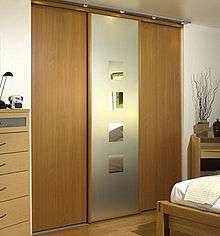Sliding door
A sliding door is a type of door which opens horizontally by sliding, usually parallel to a wall. Sliding doors can be mounted either on top of a track below or be suspended from a track above and some types 'disappear' in a wall when slid open.[1] There are several types of sliding doors such as pocket doors, Arcadia doors, and bypass doors. Sliding doors are commonly used as shower doors, glass doors, screen doors, wardrobe doors or in vans.
History
Sliding doors were used as early as the first century CE in Roman houses as evidenced by archaeological finds in Pompeii, Italy.[2][3]
Sliding door gear
The mechanism used to operate a sliding door is called sliding door gear. There are two standard types, top hung or bottom rolling systems. Both types do not have a perfect seal. To reduce air- and smoke-tightness and sound insulation, brush seals are commonly used.[1]
Top hung sliding doors

The 'top hung' system is most often used. The door is hung by two trolley hangers at the top of the door running in a concealed track; all the weight is taken by the hangers, making the door easier to move.[4]
At each end is a track stopper to absorb any impact made if the door is slammed and to hold the door in the open or closed position. All top hung sliding door gear systems have a maximum weight limit per pair of trolley hangers. When specifying a suitable sliding system the estimated weight of the door is a critical factor, although most suppliers of sliding door gear can advise on door weights
As the door is hung at the top from two points, it also needs a bottom track/stay roller[5] to prevent it from swinging sideways. The most common type is called 'clear threshold guiding', a floor-fixed plastic guide about 60mm wide which is fixed below the door at the midpoint of its run. A groove is cut into the bottom of the door which runs over this guide, preventing lateral movement of the door. With a glass door the panel runs through the guide as illustrated. Because the door is always engaged in the guide, when the door is open the floor is clear, hence 'clear threshold'
Several examples of free-standing top-hung sliding-door wardrobes can be seen on several websites. The mechanisms are safe, and the bottom of the doors is held in place on tracks. The rollers also have safety locks that prevent the doors from jumping off the tracks. Additional features such as soft closers or dampners can be added to further enhance the feel and usability of these products.
Bottom rolling door gear
Sometimes a top hung system cannot be used, as the weight of the door cannot be supported from above; in this case a bottom rolling system is recommended.
A bottom rolling system consists of two rollers (sometimes called a sheave) at the bottom of the door running on a track and two guides at the top running in a guide channel. As all the weight of the door is concentrated on the two bottom wheels, more force is needed to move the door than on a top hung system.; (cite a reference for this assertion)
Lift-and-slide door gear
A sliding door that is lifted from the frame during opening and closing is called a lift-and-slide door. This allows for a better seal, with less draught and better soundproving.[1]
Automatic sliding doors
Some sliding doors contain a motor and activation system to open them. These are called sliding door operators. Automatic sliding doors are commonly found in offices and shop entrances. These doors contain a magnetic locking mechanism that automatically unlocks during emergencies.[1]
Usage
Advantages of sliding doors are that there is almost no room required to open the door, they are relatively easy to automate. The mechanism is also secure, since it cannot be lifted out of its hinges.[6] Sliding doors are commonly found as store-, hotel- and office entrances, elevators, patios doors, closet doors and room dividers.[7] Transport industries also use sliding doors in vans, trains and metro. Volkswagen used these doors in Volkswagen Fridolin produced between 1964 and 1974.
See also
References
- 1 2 3 4 Hochberg, Anette; Hafke, Jan-Henrik; Raab, Joachim (2010). Open I Close: Windows, Doors, Gates, Loggias, Filters. Birkhäuser Verlag AG. p. 116.
- ↑ Moeller, Walter O. (1976). The Wool Trade of Ancient Pompeii. p. 47.
- ↑ Bulwer Lytton Baron Lytton, Edward (1893). The Last Days of Pompeii.
- ↑ Jones, Peter; Kornblum, Mary (1987). Shelves, Closets and Cabinets. Sterling Publishing Company, Inc. p. 80.
- ↑ Hall, Dennis J.; Giglio, Nina M. (2011). Graphic Standards Field Guide to Residential Construction. John Wiley & Sons. p. 323.
- ↑ Reid, Robert N. (2005). Facility Manager's Guide to Security: Protecting Your Assets. The Fairmont Press, Inc. p. 80.
- ↑ Simmons, Leslie L. (2011). Olin's Construction: Principles, Materials, and Methods. John Wiley & Sons.
External links
![]()
